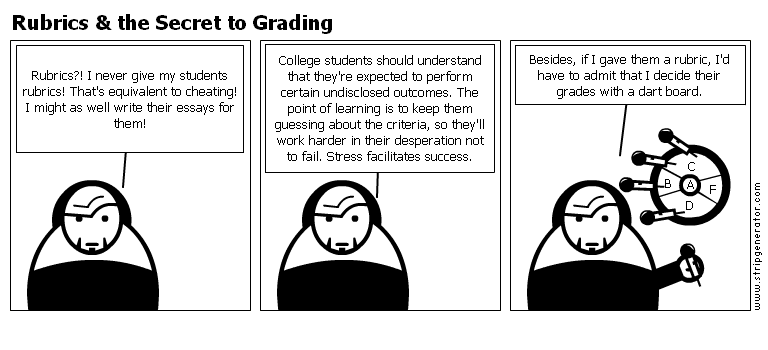9 Developing and Using Rubrics to Support Learner Success
Introduction
A rubric is a system for providing evaluation. Rubrics guide how work will be assessed and what weight will be given to each element of the work. They can enhance the transparency and consistency of grading and feedback (Western University, n.d.).

 Reflect
Reflect
Think of a time when you were a student and tasked with an assignment:
- Did the instructor provide you with a rubric so you knew what the expectations were and how you would be graded?
- Was the rubric provided to you in advance or only when the assignment was returned?
- Did you feel the expectations were clear, reasonable, and appropriate to the task?
- Did you have an opportunity to provide input on the form or content of the rubric?
- Did the rubric help you understand where you had met expectations and where you had work to do?
 Build Your Knowledge
Build Your Knowledge
The main goal of a rubric is to clarify expectations for both the instructor and the student. However, the efficacy of rubrics depends on how they are designed and used. Rubrics can offer benefits for both the learner and the instructor.
Benefits of Rubrics
Student Benefits
- clarifies the instructor’s expectations
- gives learners a goal to work towards in producing their work
- helps learners understand all of the components of the work
- gives learners greater clarity on how they can improve in future
- helps learners understand why they achieved a specific grade
Instructor Benefits
- helps to minimize miscommunication regarding assignment expectations
- leads to better and more focused work from the students
- aids in more consistent grading
- saves time in grading, both in the short and long term
- allows the instructor to spend more time on substantive comments (Western University, n.d.)
Types of Rubrics
It is important to choose the correct type of rubric for the assessment being done. We will explore three types of rubrics and their benefits: holistic, analytic, and single-point.
Holistic Rubrics
Click on the icon ![]() below to learn more about holistic rubrics.
below to learn more about holistic rubrics.
Download a holistic rubric template: Word: Holistic Rubric Template PDF: Holistic Rubric Template
Analytic Rubrics
Click on the icon![]() below to learn more about analytic rubrics.
below to learn more about analytic rubrics.
Download an analytic rubric template: Word: Analytic Rubric Template PDF: Analytic Rubric Template
Single-Point Rubrics
Click on the icon ![]() below to learn more about single-point rubrics.
below to learn more about single-point rubrics.
Download a single-point rubric template: Word: Single Point Rubric Template PDF: Single Point Rubric Template
Best Practices for Rubrics
When designing and using rubrics, it’s important to keep in mind that they should be helpful for both the educator and the learner. Studies have shown that learners perform better on assessments when they are given access to the rubric ahead of time (Becker, 2016). In order to make sure that rubrics support learners, they also need to be written in language that learners can easily understand. This is especially true for English Language Learners. Finally, rubrics may need to be revisited and revised based on learner performance and feedback.
 Key Takeaways
Key Takeaways
- Rubrics can help clarify expectations for instructors and learners.
- Rubrics should be shared with learners before they perform the assessment.
- Rubrics should be written in clear, accessible language.
- Rubrics should be explained to learners and may need to be revised based on learner feedback.
Co-constructing Rubrics
Rubrics can also help both instructors and learners clearly understand the levels of performance for an assessment. However, these levels of performance are usually set solely by the instructor with no input from learners (Skillings & Ferrell, 2000). While having access to the rubric from the beginning of the task can help learners succeed, co-creating rubrics with instructors gives learners a bigger advantage. One study (Becker, 2016) showed that English Language Learners in post-secondary classes who co-created rubrics, or used rubrics to assess their own writing, performed significantly better on writing performance than learners who simply saw the rubric in advance.
One possible reason for this, is that co-developing rubrics allowed learners to increase their metacognition about the writing process and think deeply about what makes an effective piece of writing.
What does this look like in the classroom?
- Actively involve learners in the assessment process by giving them opportunities to interact with the scoring rubric.
- Give learners the opportunity to offer input about the construction of the rubric, clarity of scoring criteria, as well as the number of score levels.
- Give learners the opportunity to practice self and peer-assessment.
- Have open discussions with learners about scoring criteria and what factors are most important for particular assignments.
- Make sure these discussions take place well before the assessment is due so that learners can ask questions.
- Based on learner questions, revise rubrics or instructions for greater clarity (Becker, 2016).
 Knowledge Check
Knowledge Check
Review the statements about rubrics below. Choose the best answer.
 Apply
Apply
- Choose an assessment in a course you teach and review the associated rubric.
- Assess if the rubric is the best kind for the type of assessment.
- Check to see that the language is clear and accessible for learners.
- Brainstorm ways you could more actively involve learners in the assessment process for this assignment.
